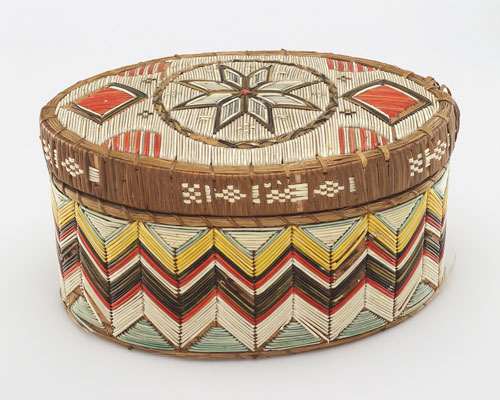The dream catcher, an honorable object, represents beauty, resilience, safeguarding, and the sacred bond among all living beings. Every thread in its web narrates a tale; every bead and feather a soft murmur of age-old knowledge. In the darkest of nights, we are always accompanied by the spirits of our ancestors, the guidance of Spider Woman, and the wisdom of Iktomi, reminding us that we are never truly alone. The dream catcher embodies profound beauty and mystery, balancing the seen and unseen, tangible and ethereal. This complex relic, hanging over where someone sleeps, holds generations of tales, knowledge, and religious importance. Deeply embedded in Native American customs, the dream catcher is more than just a form of artistic expression; it acts as a connection between different realms, a protector during nighttime.
The dream catcher’s origins are wrapped in the sacred tales of the Ojibwe and Lakota peoples, each tribe spinning its version of how this powerful object came to be. These stories passed down through generations are myths and living embodiments of the people’s values and spiritual practices.
The Ojibwe Version: The Spider Woman’s Gift
Long ago, when the world was still young, a guardian spirit known as Asibikaashi, the Spider Woman, existed. She was a protective figure, watching over the Ojibwe people, especially the children, as they slept. However, as the tribe grew and spread across the land, Asibikaashi found it challenging to reach every child. To ensure their safety, she crafted a web of protection—a dream catcher—using the willows and sinew of the earth. This web was no ordinary creation; it was imbued with the essence of the Spider Woman herself, designed to trap the dark spirits and negative dreams that threatened the children, holding them captive until the dawn’s first light could dissolve them into nothingness. The good dreams, pure and light as the morning dew, would slip through the central hole, cascading down the feathers like a gentle breeze, offering peace and guidance to the dreamer.
The Lakota Version: The Web of Life
In the Lakota tradition, the dream catcher’s origins are tied to a profound vision granted to a spiritual leader by Iktomi, the trickster spirit who took the form of a spider. In this vision, Iktomi spun a web within the leader’s willow hoop, each strand representing a choice, a path in the vast journey of life. “This web,” Iktomi explained, “is the web of life itself. The good dreams and ideas will be caught in the threads, guiding you toward wisdom and enlightenment. But beware—the bad dreams, those that seek to lead you astray, will slip through the holes and vanish with the first rays of sunlight.” The dream catcher, then, became a symbol of protection and the intricate, delicate balance of life, where every choice weaves the fabric of our existence.
Creating a dream catcher is a ritual, a meditative act that connects the artist to the ancient spirits of the earth and sky. Each component is chosen carefully, and each movement is infused with intention. The circular hoop, typically made from supple willow, symbolizes the endless cycle of life, death, and rebirth—a reminder of the interconnectedness of all beings. The web, woven with sinew or thread, mirrors the spider’s delicate yet unbreakable creation, symbolizing the weaving of fate and the capture of both good and bad dreams. Feathers are often added, allowing the gentle descent of positive dreams into the sleeper’s mind, much like a leaf floating down to rest on still waters. Beads may be threaded into the design, representing the presence of the Spider Woman or the captured bad dreams awaiting their release at dawn. It is important to note that each tribe may bring its unique touch to the dream catcher’s design, reflecting their particular beliefs and traditions. For instance, the feathers and beads serve as additional layers of symbolism for some. In contrast, others may incorporate specific colors or materials to honor their connection to the earth and sky. Each element of the dream catcher’s design carries deep spiritual significance, adding layers of meaning to this powerful object.
In the hands of a talented craftsman, the dream catcher evolves from simple components into a powerful symbol of safety, knowledge, and spiritual bond. It proves the influence of storytelling and the lasting vitality of Indigenous culture. While the dream catcher moves softly at night, it protects the dreamer’s soul by filtering harmful dark energies and guiding positive dreams into the mind. In the same way, the spider carefully and precisely weaves its web, the dream catcher also intricately combines legend, spirituality, and art to create a tapestry of protection and beauty that echoes throughout time.
Today, the dream catcher remains an essential symbol in Indigenous culture and beyond. One may commonly see dream catchers decorating homes, offices, and cars, symbolizing the lasting influence of storytelling and the unity of all living beings, even in the modern day. As the darkness recedes with the sunrise, the dream catcher finishes its quiet watch as dawn breaks and spreads light across the sky. It acts as an eternal guard, with its web crafted from the tales of ancient beings, the shielding touch of Spider Woman, and the knowledge of Iktomi. Every strand, bead, and plume murmurs stories of strength, defense, and the divine bond among all beings. Similar to the closing credits of a fulfilling film, the dream catcher’s function provides a sense of completion, ensuring that during difficult times, we are protected by the presence of our forebears and knowledge from history. It serves as a reminder that we should not fear the darkness of the night but rather seek to understand it as it is captured and dispelled by the dream catcher, letting only the brightness of our dreams lead us into a fresh day.
Works Cited
Aktá Lakota Museum & Cultural Center. “Legend of the Dreamcatcher : Aktá Lakota Museum & Cultural Center.” Aktá Lakota Museum & Cultural Center, 20 Apr. 2022, aktalakota.stjo.org/lakota-legends/legend-of-the-dreamcatcher/#:~:text=Traditionally%2C%20it%20is%20hung%20above. Accessed 16 Mar. 2024.
Johnson, Kaylin. “Dream Catchers Are More than Arts and Crafts.” Fsutorch.com, 2020, fsutorch.com/2020/10/13/dream-catchers-are-more-than-arts-and-crafts/.
“Legend of the Dream Catcher – Nanticoke Indian Tribe.” Nanticokeindians.org, 2024, www.nanticokeindians.org/about/legend-of-the-dream-catcher/. Accessed 16 Mar. 2024.
Native STAND Curricula. “Ojibwe Dreamcatcher Legend.” Wernative.org, 2019, www.wernative.org/articles/ojibwe-dreamcatcher-legend.
“Origins of the Dream Catcher – Georgian College.” Www.georgiancollege.ca, 3 Dec. 2018, www.georgiancollege.ca/blog/student-life/origins-of-the-dream-catcher/.













